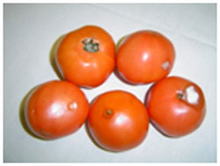Do you notice mold growing on some of the products in the back of your refrigerator? If yes, it’s probably time to clean out the refrigerator!
What is mold?
Molds are tiny fungi that live on plants or animals and can be carried by air, water or insects. Moldy foods may also have other invisible bacteria growing along with the mold.
Conditions and food where mold grows best
Molds grow best in warm, humid conditions, but can also grow at refrigerator temperatures. Molds tolerate salt and sugar and can survive on high-acid foods like jams, pickles, fruit, tomatoes and cured salty meats such as bacon, ham and bologna.
Is mold dangerous?
Some molds are dangerous because they cause allergic reactions and respiratory problems in susceptible people. Some molds also produce mycotoxins that are poisonous substances that can make people sick. When food looks moldy, the mold spores have already invaded deeply into the product. Mycotoxins are most often contained in and around these spores but may also spread throughout the food.
Tips to control mold
Control mold by keeping everything clean. Mold spores from moldy foods can build up in the refrigerator, dishcloth and other cleaning utensils. Follow these tips to control or reduce mold:
- Clean the inside of the refrigerator every few months with 1 tablespoon baking soda in one quart of water. Rinse with clean water and dry. Scrub visible mold (usually black in color) on rubber casings using 3 teaspoons of bleach in a quart of water.
- Keep dishcloths, towels, sponges and mops clean and fresh. If they smell musty, they are spreading mold! Throw out anything you can’t keep clean.
- Keep your home’s humidity level below 40%.
- Check out items (e.g. bread and fresh produce) before you purchase items in the grocery store.
- Check out cured meats and poultry. NOTE: Some salamis have a thin, white mold coating which is safe to eat. Dry-cured country hams normally have surface mold that must be scrubbed off before cooking.
What to do with moldy food
If you see moldy food, do not smell or sniff it. Throw out the food by putting it into a small paper bag or wrapping it in plastic and throwing it in a covered trash can away from children or animals. Clean the refrigerator or pantry, especially in the area where the food was stored and check nearby items that the moldy food might have touched. Mold spreads quickly in fruits and vegetables.
In general, it’s best to throw out any food that has become moldy, with the exception of hard cheese, hard salami, dry-cured ham and firm produce like carrots and bell pepper. Because it’s difficult for molds to deeply penetrate these products, they can be saved if they are not heavily affected by mold. To save the product, cut off at least 1 inch around and below the mold spot, keeping the knife out of the mold to prevent cross-contaminating other parts. After trimming off the mold, re-cover in fresh wrap.
Reviewed in 2021


